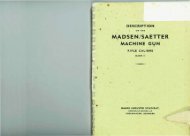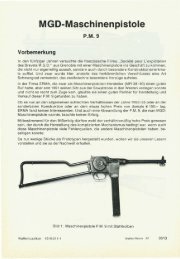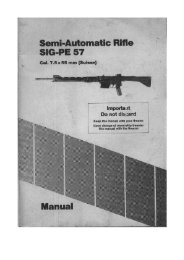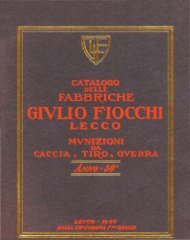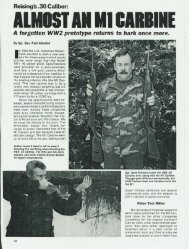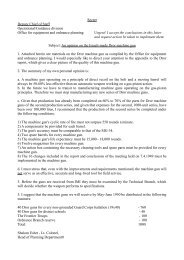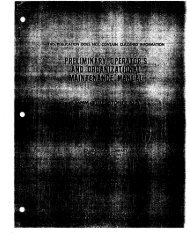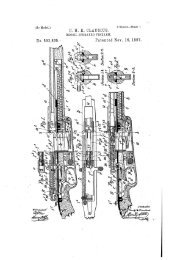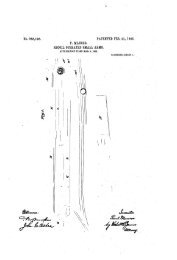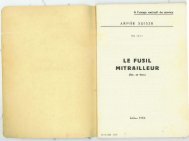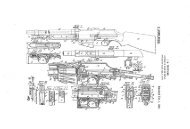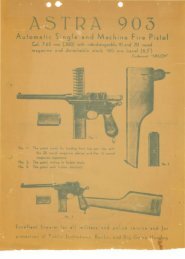8 inc Howitzer manual.pdf - Replica Plans and Blueprints
8 inc Howitzer manual.pdf - Replica Plans and Blueprints
8 inc Howitzer manual.pdf - Replica Plans and Blueprints
You also want an ePaper? Increase the reach of your titles
YUMPU automatically turns print PDFs into web optimized ePapers that Google loves.
o·<br />
be<br />
ge<br />
hE<br />
ar<br />
ar<br />
ar<br />
p!<br />
or<br />
tl:<br />
rr<br />
t2<br />
el<br />
h<br />
c<br />
sJ<br />
p<br />
1<br />
g<br />
t<br />
r<br />
1:<br />
43<br />
head prism holder (Y), upon which the elevation segment (WS) is cut,<br />
is accomplished by the elevation worm (El ), <strong>and</strong> the length of travel is<br />
controlled by seven brass stop rings (R2). Each ring has a small tongue,<br />
the edge of which engages at each revolution of the elevation worm<br />
(E1) with the tongue on the adjacent ring. Each Ting is thus engaged<br />
in its turn until si .. 'C revolutions have been made, when the tongues<br />
are all in contact. <strong>and</strong> no further movement can be made in that<br />
direction.<br />
The prism shield (S1) is held within the rotating head (RH) by the<br />
prism shield retaining piece (3A), which is in turn secured by two<br />
prism shield retaining piece screws (2A).<br />
The prism holder cover (02) scTews into its threaded seat located<br />
in the right side of the rotating head prism holder (Y) <strong>and</strong> is locked<br />
in position by the prism holder cover screw (03).<br />
The rotating head cover (Cl) screws into its threaded seat located in<br />
the right side of the rotating head (RH) <strong>and</strong> is held in place by the<br />
rotating head cover screw (S7). The exterior of the rotating head cover<br />
(Cl) has two small holes for teat >aench, <strong>and</strong> engravings "Field 10° "<br />
<strong>and</strong> "Power 4" are located on the exterior surface.<br />
The elevation index support (G2) screws into its threaded seat<br />
located in the left side of the rotating head prism holder (Y), <strong>and</strong> is<br />
secured in place by the elevation index support screw (G7). The<br />
small holes in the exterior surface allow the use of a teat wrench, to<br />
enable the elevation index support (G2) to be screwed in place. The<br />
support retaining ring (G4) retains the elevation index support with<br />
rotating head prism holder within the rotating head <strong>and</strong> is locked in<br />
position by the supporting ring screw (G5).<br />
The elevation index (G6) is held upon the elevation index support<br />
(G2) by the two elevation index retaining screws (GS). The arrow<br />
engraved upon the German-silver piece which is dovetailed in the<br />
elevation index (G6) co<strong>inc</strong>ides with the graduations of the scale (G3)<br />
engraved upon the real' face of the rotating head (RH).<br />
ELEVATION DEVICE.<br />
The elevation device consists pr<strong>inc</strong>ipally of the elevation segment<br />
(WS), elevation worm (El), elevation worm ball cap <strong>and</strong> socket (1B<br />
<strong>and</strong> 2B), elevation worm plunger spring <strong>and</strong> plug (S3 <strong>and</strong> B2), elevation<br />
micrometer (R1), seven stop rings (R2), <strong>and</strong> elevation index<br />
(G6).<br />
The elevation segment (WS) is hob bed into the rotating head prism<br />
holder (Y) <strong>and</strong> meshes with the elevation worm (E1).<br />
The elevation worm (E1) is mounted in the back of the rotating<br />
head (RH) in a ball <strong>and</strong> socket bearing (2B ), which in conjunction with




